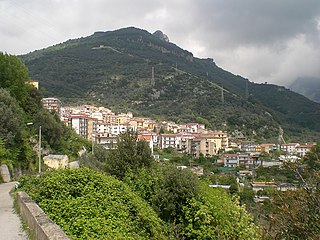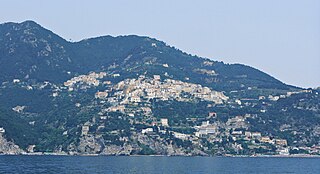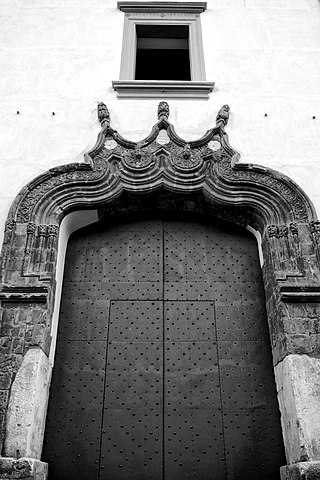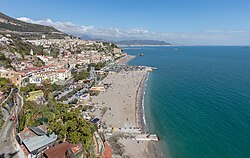
Lodi is a city and comune in Lombardy, northern Italy, primarily on the western bank of the River Adda. It is the capital of the province of Lodi.

The Amalfi Coast is a stretch of coastline in southern Italy overlooking the Tyrrhenian Sea and the Gulf of Salerno. It is located south of the Sorrentine Peninsula and north of the Cilentan Coast.

Cava de' Tirreni is a city and comune in the region of Campania, Italy, in the province of Salerno, 10 kilometres northwest of the town of Salerno. It lies in a richly cultivated valley surrounded by wooded hills, and is a popular tourist resort. The abbey of La Trinità della Cava is located there.

Campagna is a small town and comune of the province of Salerno, in the Campania region of Southern Italy. Its population is 17,148. Its old Latin name was Civitas Campaniae. Campagna is located in one of the valleys of the Picentini Mountains, at an altitude of 270 meters above sea level.

Montepulciano is a medieval and Renaissance hill town and comune in the Italian province of Siena in southern Tuscany. It sits high on a 605-metre (1,985 ft) limestone ridge, 13 kilometres (8 mi) east of Pienza, 70 kilometres (43 mi) southeast of Siena, 124 kilometres (77 mi) southeast of Florence, and 186 kilometres (116 mi) north of Rome by car.

Giugliano in Campania, also known simply as Giugliano, is a city and comune (municipality) in the Metropolitan City of Naples, Campania, Italy. A suburb of Naples, as of 2017, it had some 124,000 inhabitants, making it the most populated Italian city that is not a provincial capital.
Cetara is a town and comune in the province of Salerno in the Campania region of south-western Italy. It is located in the territory of the Amalfi Coast.

Olevano sul Tusciano is a town and comune in the province of Salerno in the Campania region of south-western Italy.

Oliveto Citra is a town and comune in the province of Salerno in the Campania region of south-western Italy. It is located 55 kilometres (34 mi) by road northeast of Salerno. As of 2016, the comune had 3,802 inhabitants and covered an area of 31.62 square kilometres (12.21 sq mi).

The Royal Palace of Portici is a former royal palace in Portici, Southeast of Naples along the coast, in the region of Campania, Italy. Today it is the home of the Orto Botanico di Portici, a botanical garden operated by the University of Naples Federico II. These gardens were once part of the large royal estate that included an English garden, a zoo and formal parterres.

Montepescali is a small town in southern Tuscany, Italy, a frazione of the comune of Grosseto. The site, from which the scenic panorama of the coastal strip and the Tuscan Archipelago up to Corsica can be seen, is also known as "Terrace or balcony of the Maremma".

Raito is an Italian hamlet (frazione) of the municipality of Vietri sul Mare in the Province of Salerno, Campania. It is part of the Amalfi Coast and its population is 996.

The Museo Provinciale Campano di Capua is a provincial museum located in Capua, southern Italy. Established in 1870 and inaugurated in 1874, it is housed in the historic Palazzo Antignano. The museum is dedicated to ancient Italian civilization in Campania, and is home to an extensive collection of ritual statues representing matres matutae coming from the ancient Roman site of Capua antica. It also hosts the second largest lapidarium in the region, after that of the National Archaeological Museum of Naples.
Olga Napoli was an Italian painter, considered one of the most complex artists of the Southern Italian Post-World War II cultural landscape.

Lodi ceramics are ceramics produced in Lodi, a city in the Lombardy region of Northern Italy. Their artistic quality reached its peak in the 18th century.
Irene Kowaliska was a painter, ceramics artist and textiles designer, originally from Mazovia. In 1931 she accepted a job at a German-owned ceramics manufactory in Campania, and during the 1930s it was in Italy that she built and thereafter sustained her career and professional reputation.

The Museum Giuseppe Gianetti is a ceramics museum located in Saronno, Italy. The Museum includes collections of different types of porcelain, majolica, and ceramics that belonged to the Italian industrialist Giuseppe Gianetti. These showcase more than 200 pieces of Meissen porcelain, which represents the Museum's most substantial collection. Other collections cover Oriental porcelain, Italian and European majolica, and porcelain. The original collections have been expanded to include the Aldo Marcenaro Collection and a collection of contemporary ceramics.



















